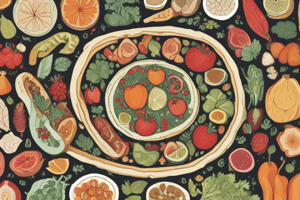Podcast
Questions and Answers
What does the Household Dietary Diversity Score (HDDS) primarily assess?
What does the Household Dietary Diversity Score (HDDS) primarily assess?
- Household economic ability to purchase food
- Self-reported dietary habits of children only
- Variety of food groups consumed in the past week (correct)
- Nutritional deficiencies based on food intake
Which food consumption situation indicates a 'poor' status according to the Food Consumption Score (FCS)?
Which food consumption situation indicates a 'poor' status according to the Food Consumption Score (FCS)?
- Acceptable ≤42
- Poor ≤21 (correct)
- Borderline ≤28
- Average ≤30
In the context of assessing food insecurity, what is the role of self-reported data in the FCS?
In the context of assessing food insecurity, what is the role of self-reported data in the FCS?
- It measures the emotional impact of food scarcity
- It determines the financial cost of food for the household
- It provides insights into food preparation methods
- It helps calculate the frequency of food consumption among household members (correct)
Which food groups are weighted by their nutritional importance in calculating the Food Consumption Score?
Which food groups are weighted by their nutritional importance in calculating the Food Consumption Score?
What is a major driver of food insecurity that impacts household dietary diversity?
What is a major driver of food insecurity that impacts household dietary diversity?
Which factor is NOT part of the evaluation for the Food Consumption Score (FCS)?
Which factor is NOT part of the evaluation for the Food Consumption Score (FCS)?
How are the food groups categorized within the Household Dietary Diversity Score?
How are the food groups categorized within the Household Dietary Diversity Score?
What is the significance of having a high dietary diversity score in a household?
What is the significance of having a high dietary diversity score in a household?
Which food category is least likely to provide significant nutritional value in terms of energy and protein?
Which food category is least likely to provide significant nutritional value in terms of energy and protein?
What is the primary nutritional concern associated with dairy products in terms of diet?
What is the primary nutritional concern associated with dairy products in terms of diet?
Which food group has the highest energy density but typically lacks micronutrients?
Which food group has the highest energy density but typically lacks micronutrients?
Which category contains foods that generally have a lower quality protein compared to meats?
Which category contains foods that generally have a lower quality protein compared to meats?
Which factor is NOT considered a key driver impacting food availability?
Which factor is NOT considered a key driver impacting food availability?
Which of the following could be classified as a social factor impacting food stability?
Which of the following could be classified as a social factor impacting food stability?
Which of the following best describes the nutrient profile of vegetables?
Which of the following best describes the nutrient profile of vegetables?
What is a significant limitation of cereals, grains, roots, and tubers regarding protein content?
What is a significant limitation of cereals, grains, roots, and tubers regarding protein content?
What aspect does food utilization NOT directly involve?
What aspect does food utilization NOT directly involve?
Which of the following dimensions primarily addresses whether households can physically acquire food?
Which of the following dimensions primarily addresses whether households can physically acquire food?
Which statement accurately reflects the role of sugar and sugar products in the diet?
Which statement accurately reflects the role of sugar and sugar products in the diet?
Which category is defined for foods eaten in very small quantities, thus not significantly impacting overall diet quality?
Which category is defined for foods eaten in very small quantities, thus not significantly impacting overall diet quality?
Which of the following drivers would NOT influence the accessibility of food?
Which of the following drivers would NOT influence the accessibility of food?
What is the primary characteristic of household dietary diversity concerning legumes/nuts?
What is the primary characteristic of household dietary diversity concerning legumes/nuts?
What does a score of 3 on the Household Hunger Scale indicate?
What does a score of 3 on the Household Hunger Scale indicate?
Which coping strategy indicates the most severe level of food insecurity according to the rCSI?
Which coping strategy indicates the most severe level of food insecurity according to the rCSI?
In the context of food insecurity analysis, which tool is used to assess recent food access problems?
In the context of food insecurity analysis, which tool is used to assess recent food access problems?
Which factor is least likely to be a driver of food insecurity?
Which factor is least likely to be a driver of food insecurity?
What is the primary purpose of the Reduced Coping Strategies Index (rCSI)?
What is the primary purpose of the Reduced Coping Strategies Index (rCSI)?
Which of the following strategies is scored the highest in the rCSI for severe food insecurity?
Which of the following strategies is scored the highest in the rCSI for severe food insecurity?
When a household reports employing a strategy to cope with food insecurity how is this measured in the rCSI framework?
When a household reports employing a strategy to cope with food insecurity how is this measured in the rCSI framework?
What does the frequency score in the rCSI represent?
What does the frequency score in the rCSI represent?
Which strategy contributes the least to mitigating food insecurity based on the presented options?
Which strategy contributes the least to mitigating food insecurity based on the presented options?
Which of the following is NOT a component assessed by the Reduced Coping Strategies Index?
Which of the following is NOT a component assessed by the Reduced Coping Strategies Index?
Which statement best describes the purpose of the IPC Food Security Analytical Framework?
Which statement best describes the purpose of the IPC Food Security Analytical Framework?
What is the role of household level measurements in food security analysis?
What is the role of household level measurements in food security analysis?
Which of the following is NOT a part of the IPC Food Security Analytical Framework's measurement tools?
Which of the following is NOT a part of the IPC Food Security Analytical Framework's measurement tools?
What key driver has been identified as contributing to worsening food insecurity after the Beirut port explosion?
What key driver has been identified as contributing to worsening food insecurity after the Beirut port explosion?
Which measurement is used to evaluate the variety of foods consumed in a household?
Which measurement is used to evaluate the variety of foods consumed in a household?
What is the primary focus of the Reduced Coping Strategies Index (rCSI)?
What is the primary focus of the Reduced Coping Strategies Index (rCSI)?
Which element is essential in forming a comprehensive analysis team for food security assessment?
Which element is essential in forming a comprehensive analysis team for food security assessment?
What type of tool is explicitly stated as NOT being part of the IPC framework?
What type of tool is explicitly stated as NOT being part of the IPC framework?
What is the focus of the Economic Capacity to Meet Essential Needs (ECMEN)?
What is the focus of the Economic Capacity to Meet Essential Needs (ECMEN)?
Flashcards are hidden until you start studying
Study Notes
Household Dietary Diversity Score (HDDS)
- Reflects economic ability to access variety of foods
- Based on 24-hour self-reported food group consumption
- Score varies based on number of food groups consumed
- Simplified scale for children (8 food groups)
Food Consumption Score (FCS)
- Composite score reflecting food consumption and frequency
- Uses 9 food groups and considers consumption over past 7 days
- Food groups have assigned weights based on nutritional importance
- Score is based on self-reported information
Food Groups and Weights for FCS
- Meat, fish, and eggs: 4 - High-quality protein, micronutrients, and energy-dense
- Milk: 4 - High-quality protein, micronutrients, and vitamin A, but should be considered a condiment if consumed in small amounts.
- Pulses: 3 - Energy-dense, high protein, but lower quality compared to meat, and contain micronutrients
- Staples: 2 - Energy-dense, lower protein quality, and micronutrients bound by phytates
- Vegetables: 1 - Low energy, low protein, no fat, micronutrients
- Fruits: 1 - Low energy, low protein, no fat, micronutrients
- Oil: 0.5 - Energy-dense but usually no other micronutrients, consumed in small quantities
- Sugar: 0.5 - Empty calories, consumed in small quantities
- Condiments: 0 - Consumed in small quantities, minimal impact on diet
Household Hunger Scale (HHS)
- Developed by FANTA
- Assesses food access challenges in households
- Measures frequency of food access issues over past 30 days
- Response options: 0 (no), 1 (rarely), 2 (sometimes), 3 (often)
Reduced Coping Strategies Index (rCSI)
- Developed by CARE International and validated by FANTA and WFP
- Captures frequency of food coping strategies used over past 7 days
- Strategies include:
- Relied on less preferred food
- Borrowed food or relied on help from friends/relatives
- Reduced number of meals per day
- Reduced portion size of meals
- Restricted adult consumption to allow children to eat
- Each strategy has a weight from 0 to 7 based on severity
IPC Food Security Analytical Framework
- Uses multi-stakeholder approach for food security analysis
- Relies on in-depth understanding of local situations
- Includes food security experts and global experts
- Aims to assess first-level outcomes for:
- Food Consumption
- Livelihood Change
Household Level Measurements in the Framework
- Individual-level measurements are used as a proxy for individual nutritional quality
- Household-level measurements are used as a proxy for household socio-economic level
- Should be answered by the individual responsible for meal preparation
Measurements of Food Consumption in IPC Framework
- Acute settings:
- Household Dietary Diversity Score (HDDS): Developed by Food and Nutrition Technical Assistance (FANTA), uses 12 food groups.
- Food Consumption Score (FCS): Based on consumption frequency and food group weights.
- Household Hunger Scale (HHS): Developed by FANTA, assesses food access challenges in households.
- Reduced Coping Strategies Index (rCSI): Tracks frequency of food coping strategies.
- Household Economy Analysis (HEA): Assesses economic capacity to meet essential needs.
Dimensions of Food Security
- Availability: Physical presence of food. Key drivers include production, imports, and food aid.
- Accessibility: Ability of households to access food through different sources. Key Drivers include household resources, food prices, preferences, and socio-political factors.
- Utilization: How efficiently households utilize food for adequate nutrition and energy intake. Key drivers include household income, food preferences, health status, and access to healthcare.
- Stability: Stability of the food system and its vulnerability to disruptions. Key drivers include climatic, economic, social, and political factors.
Studying That Suits You
Use AI to generate personalized quizzes and flashcards to suit your learning preferences.





